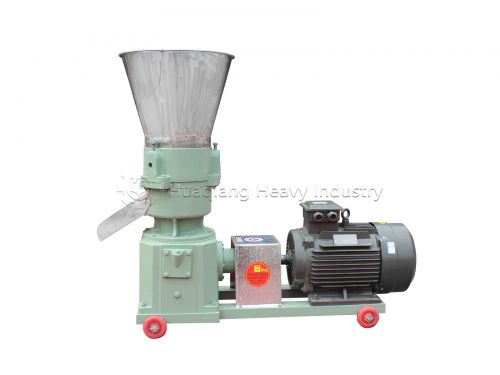The flat die granulator is a commonly used machine for forming fertilizer granules. Its unique structure occupies a key position in small and medium-sized production lines, and its working principle and performance advantages are outstanding.

The core operating principle is "extrusion molding." The machine features a disc-shaped flat die with uniform apertures at the bottom, topped by a rotating roller. Pretreated raw materials (powder or paste with a moisture content of 15%-20%) enter the machine cavity, where the rotating rollers continuously press the raw materials against the die surface. Under pressure, the raw materials are squeezed into the die holes, forming cylindrical strands. These strands are then cut into pellets of a desired length by a cutter located outside the die holes. The entire process eliminates the need for high-temperature melting, relying solely on mechanical extrusion and physical molding. This makes it suitable for processing heat-sensitive raw materials such as organic fertilizers and biofertilizers, ensuring maximum retention of the raw materials' active ingredients.
The flat die granulator has significant advantages. Firstly, its simple structure and easy operation. Compared to ring die pelletizers, this machine is compact, with its core components consisting only of a flat die, rollers, and cutters. This makes disassembly easy for maintenance and requires minimal operator skill, making it suitable for small and medium-sized enterprises.
Secondly, it offers strong adaptability to various raw materials. Crude fiber organic fertilizers like straw and manure, as well as compound fertilizers containing nitrogen, phosphorus, and potassium, can all be granulated stably by properly adjusting the moisture content and pressure parameters. Die clogging is less likely to occur when processing materials high in crude fiber, ensuring excellent operational stability.
Furthermore, pellet quality is highly controllable. Adjusting the cutter speed changes pellet length, while adjusting the pressure allows for controlled pellet hardness. The pellets produced are dense and resistant to breakage, resist pulverization during transportation and storage, and dissolve evenly in water, meeting the physical property requirements of fertilizers required by modern agriculture.
Furthermore, it offers significant energy and cost advantages. Its drive power is lower than that of ring die equipment with the same production capacity, resulting in approximately 20% lower energy consumption per pellet, low replacement costs for wearing parts, and excellent long-term economical operation. These features make the flat die granulator the preferred equipment for fertilizer granulation production that takes into account both efficiency and applicability.